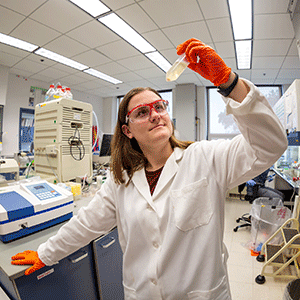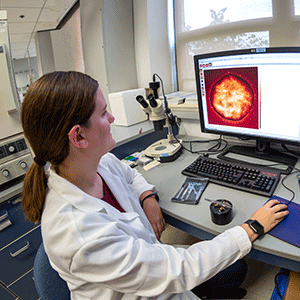A soldier has many worries—but fungus growing on military tents shouldn’t be one of them.
That’s where Endicott College student Kaitlyn Nadeau ’20 comes in. A senior majoring in bioengineering, she worked with renowned researchers at the U.S. Army Combat Capabilities Development Command to determine the impact of fungus growth on portable combat tents. As part of her semester-long internship, she dove deep into the world of biomolecular science, and gained marketable skills and knowledge to last a lifetime.
Digging Right In
As part of Endicott’s unique four-year internship program, Nadeau interned at the Combat Capabilities Development Command (CCDC), a facility where researchers perform a variety of experiments to ultimately ensure soldiers are prepared and protected at camp and on the battlefield. One area of research is the shelter provided by combat tents.Throughout history, the U.S. Army used a variety of materials to produce tents, including duck, linen, cotton, canvas, khaki and more. Today’s tents are mainly composed of PVC textiles, which comprise a variety of synthetic fibers. While PVC doesn’t succumb to rot as easily as say cotton, it is still susceptible to a particular fungus growth: Aureobasidium pullulans (or AP) and it’s surfacing in all environmental conditions, from the rainforest to the desert.
 “AP is the first colonizer, and it’s allowing other fungus types to colonize, and that ultimately degrades the synthetic material,” says Nadeau. “It’s the only fungus to start to colonize on these PVC synthetic tents.”
“AP is the first colonizer, and it’s allowing other fungus types to colonize, and that ultimately degrades the synthetic material,” says Nadeau. “It’s the only fungus to start to colonize on these PVC synthetic tents.”
As a biomolecular research intern, Nadeau worked with the CCDC’s Biological Science and Technology team to isolate, identify and characterize the fungi elements to determine how they are binding to the synthetic surfaces. The research called for extreme attention to detail. Nadeau worked on deriving the fungus spores down to a polysaccharide, a carbohydrate whose molecules consist of a number of sugar molecules bonded together. Once she had the polysaccharide, she worked on ways to functionalize it on to an atomic force microscope (AFM), a type of high-resolution scanning probe that has a resolution you can measure in fractions of a nanometer. The long-term goal is to determine and measure the adhesive forces of the AP fungus, which will help in choosing a synthetic surface that best fits the Army’s portable tents while not allowing the fungi to decompose the surface.
“We spent many weeks researching how to functionalize the AFM probe,” says Nadeau. “And we ended up finding two protocols to test, which was great. We found one of them is probably going to work.”
Real-World Applicability
Nadeau’s specialized work with the CCDC, and collaboration with its biological research scientists and chemists, helped her learn new techniques, data analyses and laboratory workflows—skills she can apply to any career within the bioengineering field.
Much of what she learned in Endicott courses helped prepare her for the demanding CCDC internship. She says her chemistry and biology courses—and their professors—were instrumental in teaching the basics for techniques in the laboratory.

Nadeau also held two previous internships, working with mechanical and quality engineers to help employees as they assembled medical devices. “Both internships helped with my professional development, and helped me to make really good connections and future references,” she says. “But the CCDC internship has definitely given me more of a focus of what I want to do in the future. With bioengineering, I can go in so many different ways, which is why I chose the major. I can work in a range of fields, from medical to biological sciences.”
Nadeau found that lab work, especially researching matter she never worked with before, was exciting. Applying that lab work into a military setting was especially appealing. Nadeau says she has family members in the military and was always interested in the ROTC.
With approximately 50 soldiers on base, the CCDC is unique in that researchers are able to test the equipment in real-life, onsite scenarios. And Nadeau is energized that her research aids in protecting and increasing the survivability of such a special population: the men and women charged with serving and protecting our country.
Learn more about research at Endicott and see how its bioengineering program can prepare you for a variety of careers.

